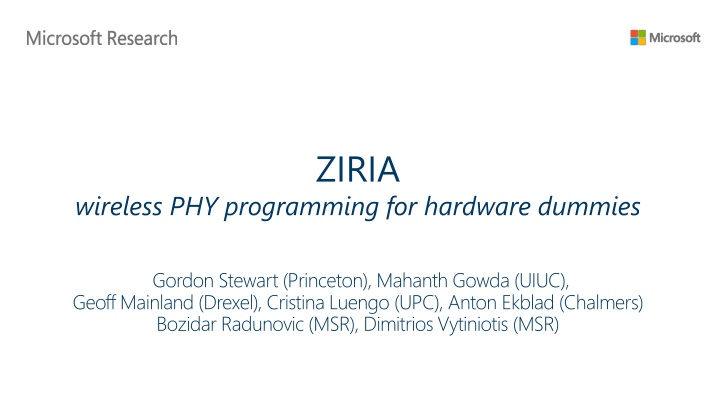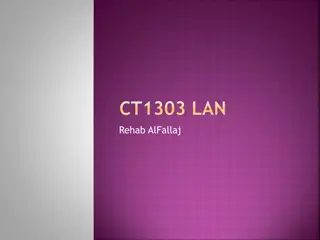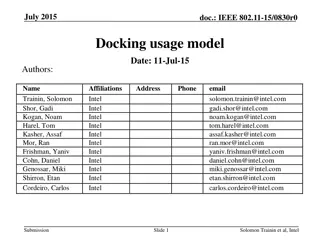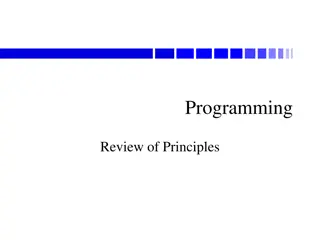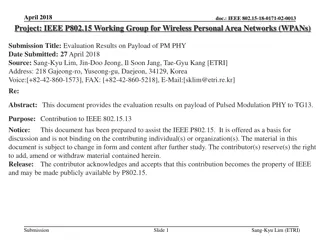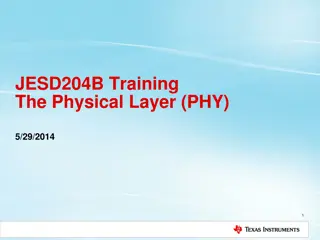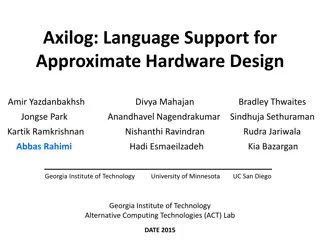Innovations in Wireless PHY Programming for Hardware
Programming software radios is a key aspect of wireless communication research, with recent advancements in PHY/MAC design and the use of SDR platforms like GNURadio and SORA for experimentation. Challenges include FPGA limitations and the need for hardware synthesis platforms like ZIRIA for high-level programmability. Manual optimizations in SDR, such as dataflow pipeline widths and bit-fiddling code, are crucial for achieving fast computations. The use of dataflow abstractions like vertices in a graph is common in SDR development.
Uploaded on Sep 18, 2024 | 0 Views
Download Presentation

Please find below an Image/Link to download the presentation.
The content on the website is provided AS IS for your information and personal use only. It may not be sold, licensed, or shared on other websites without obtaining consent from the author.If you encounter any issues during the download, it is possible that the publisher has removed the file from their server.
You are allowed to download the files provided on this website for personal or commercial use, subject to the condition that they are used lawfully. All files are the property of their respective owners.
The content on the website is provided AS IS for your information and personal use only. It may not be sold, licensed, or shared on other websites without obtaining consent from the author.
E N D
Presentation Transcript
ZIRIA wireless PHY programming for hardware dummies Gordon Stewart (Princeton), Mahanth Gowda (UIUC), Geoff Mainland (Drexel), Cristina Luengo (UPC), Anton Ekblad (Chalmers) Bozidar Radunovic (MSR), Dimitrios Vytiniotis (MSR)
Programming software radios Typical scenario: RF + A/D sends samples through PCI-express to CPU. All PHY/MAC processing done on CPU Lots of recent innovation in PHY/MAC design Communities: MobiCom, SIGCOMM Software Defined Radio (SDR) platforms useful for experimentation and research GNURadio (C/C++, Python) predominant platform relatively easy to program, lots of libraries slow; first real-time GNURadio WiFi RX in appeared only last year SORA (MSR Asia): C++ library + custom hardware lots of manual optimizations, hard to modify SORA pipelines, shared state A A breakthrough breakthrough: extremely : extremely fast code and libraries! 2
The problem Essentially the traditional complaints against FPGAs Error prone designs, latency-sensitivity issues Code semantics tied to underlying hardware or execution model Hard to maintain the code, big barrier to entry become valid against software platforms too become valid against software platforms too, undermining the very advantages of software! Airblue [ANCS 10] offered a solution: a hardware synthesis platform that offers latency-insensitivity and high-level programmability ZIRIA: similar goals for software implementations hardware synthesis platform 3
SDR manual optimizations (SORA) struct _init_lut { void operator()(uchar (&lut)[256][128]) { int i,j,k; uchar x, s, o; for ( i=0; i<256; i++) { for ( j=0; j<128; j++) { x = (uchar)i; s = (uchar)j; o = 0; for ( k=0; k<8; k++) { Hand-written bit-fiddling code to create lookup tables for specific computations that must run very fast uchar o1 = (x ^ (s) ^ (s >> 3)) & 0x01; s = (s >> 1) | (o1 << 6); o = (o >> 1) | (o1 << 7); x = x >> 1; } lut [i][j] = o; } } } } and more e.g. manual provision of dataflow pipeline widths 4
Another problem: dataflow abstractions Predominant abstraction used (e.g. SORA, StreamIt, GnuRadio) is that of a vertex in a dataflow graph Reasonable as abstraction of the execution model (ensures low-latency) Unsatisfactory as programming and compilation model Why unsatisfactory? It does not expose: (1) When is vertex state (re-) initialized? (2) Under which external control messages can the vertex change behavior? (3) How can vertex transmit control information to other vertices? Events (messages) come in Events (messages) come out 5
Example: dataflow abstractions in SORA DEFINE_LOCAL_CONTEXT(TBB11aRxRateSel, CF_11RxPLCPSwitch, CF_11aRxVector ); template<TDEMUX5_ARGS> class TBB11aRxRateSel : public TDemux<TDEMUX5_PARAMS> { CTX_VAR_RO (CF_11RxPLCPSwitch::PLCPState, plcp_state ); CTX_VAR_RO (ulong, data_rate_kbps ); // data rate in kbps public: .. public: REFERENCE_LOCAL_CONTEXT(TBB11aRxRateSel); void Reset() { Next0()->Reset(); // No need to reset all path, just reset the path we used in this frame switch (data_rate_kbps) { case 6000: case 9000: Next1()->Reset(); break; case 12000: case 18000: Next2()->Reset(); break; case 24000: case 36000: Next3()->Reset(); break; case 48000: case 54000: Next4()->Reset(); break; } } STD_DEMUX5_CONSTRUCTOR(TBB11aRxRateSel) BIND_CONTEXT(CF_11RxPLCPSwitch::plcp_state, plcp_state) BIND_CONTEXT(CF_11aRxVector::data_rate_kbps, data_rate_kbps) {} Shared state with other components Verbose, hinders fast prototyping Implementation of component relies on dataflow graph! 6
What is state and control: WiFi RX Payload modulation parameters: A control value Channel characteristics: a control value Transmission detected: a control value Packet start Channel info Channel Estimation Invert Channel Invert Channel DetectSTS Packet info Decode Header Decode Packet Detect if we have transmission: Processing while updating internal state Estimates the effects of the communication channel 7
A great opportunity to use functional programming ideas in a high-performance scenario Better dataflow abstractions for capturing state initialization and control values We identify an important gap: a lot of related work focuses more on efficient DSP (e.g. SORA, Spiral, Feldspar, StreamIt) and much less on control, but e.g. LTE spec is 400 pages with a handful (and mostly standardized) DSP algorithms Better automatic optimizations (1) (2) (3) 8
ZIRIA A non-embedded DSL for bit stream and packet processing Programming abstractions well-suited for wireless PHY implementations in software (e.g. 802.11a/g) Optimizing compiler that generates real-time code Developed @ MSR Cambridge, open source under Apache 2.0 www.github.com/dimitriv/Ziria http://research.microsoft.com/projects/Ziria Repo includes WiFi RX & TX PHY implementation for SORA hardware 9
ZIRIA: A 2-level language Lower-level Imperative C-like language for manipulating bits, bytes, arrays, etc. Statically known array sizes Aimed at EE crowd (used to C and Matlab) Higher-level: Monadic language for specifying and composing stream processors Enforces clean separation between control and data flow Intuitive semantics (in a process calculus) Runtime implements low-level execution model inspired by stream fusion in Haskell provides efficient sequential and pipeline-parallel executions 10
ZIRIA programming abstractions inStream (a) inStream (a) outControl (v) t c outStream (b) outStream (b) A stream computer c, of type: ST (C v) a b A stream transformer t, of type: ST T a b * Types similar to (but a lot simpler than) Haskell Pipes 11
Control-aware streaming abstractions inStream (a) inStream (a) outControl (v) t c outStream (b) outStream (b) take :: ST (C a) a b emit :: v -> ST (C ()) a v map :: (a -> b) -> ST T a b repeat :: ST (C ()) a b -> ST T a b 12
Data- and control-path composition Drain-from- downstream semantics (>>>) :: ST T a b -> ST T b c -> ST T a c (>>>) :: ST (C v) a b -> ST T b c -> ST (C v) a c (>>>) :: ST T a b -> ST (C v) b c -> ST (C v) a c Composition along control path (like a monad*) Reinventing a Swedish classic: The Fudgets GUI monad [Carlsson & Hallgren, 1996] Composition along data path (like an arrow) (>>=) :: ST (C v) a b -> (v -> ST x a b) -> ST x a b return :: v -> ST (C v) a b Like Yampa s switch, but using different channels for control and data Monad similar to Elliott s Task monad [PADL 99] 13
Composing pipelines, in diagrams Monadic seq notation T C seq { x <- m1; m2 } === m1 >>= (\x -> m2) c1 t2 seq { v <- (c1 >>> t1) ; t2 >>> t3 } t1 t3 14
High-level WiFi RX skeleton Channel info Packet start Channel Estimation Invert Channel Invert Channel DetectSTS Packet info Decode Header Decode Packet let comp wifi_rx = seq { pstart <- detectSTS() ; cinfo <- estimateChannel(pstart) ; pinfo <- invertChannel(cinfo) >>> decodeHeader() ; invertChannel(cinfo) >>> decodePacket(pinfo) } 15
Plugging in low-level imperative code let comp scrambler() = var scrmbl_st: arr[7] bit := {'1,'1,'1,'1,'1,'1,'1}; var tmp,y: bit; repeat { (x:bit) <- take; do { tmp := (scrmbl_st[3] ^ scrmbl_st[0]); scrmbl_st[0:5] := scrmbl_st[1:6]; scrmbl_st[6] := tmp; y := x ^ tmp }; Low-level imperative code Lifted with do emit (y) } 16
CPU execution model Every c :: ST (C v) a b compiles to 3 functions: tick :: () St (Result v b + NeedInput) process :: a St (Result v b) init :: () St () data Result v b ::= Skip | Yield b | Done v Compilation task: compose* tick(), process(), init() compositionally from smaller blocks * Actual implementation uses labeled blocks and gotos 17
Main loop write b to output tick() Result v b Skip Yield(b) Done(v) NeedInput read a from input process(a) write v to ctrl output 18
CPU scheduling: no queues Ticking (c1 >>> c2) starts from c2, processing (c1 >>> c2) starts from c1 Reason: design decision to avoid introducing queues as result of compilation Actually queues could be introduced explicitly by programmers, or as a result of vectorization (see later) but we guarantee that upon control transitions no un-processed data remains in the queues (which is on of the main reasons SORA pipelines are hard to modify!) Ticking/processing seq { x <- c1; c2 } starts from c1; when Done, we init() c2 and start ticking/processing on c2 19
Optimizing ZIRIA code 1. Exploit monad laws, partial evaluation 2. Fuse parts of dataflow graphs 3. Reuse memory, avoid redundant memcopying 4. Compile expressions to lookup tables (LUTs) 5. Pipeline vectorization transformation 6. Pipeline parallelization The rest of the talk 20
Pipeline vectorization Problem statement Problem statement: given (c :: ST x a b), automatically rewrite it to c_vect :: ST x (arr[N] a) (arr[M] b) for suitable N,M. Benefits of Benefits of vectorization vectorization Fatter pipelines => lower dataflow graph interpretive overhead Array inputs vs individual elements => more data locality Especially for bit-arrays, enhances effects of LUTs 21
Computer vectorization feasible sets Assume we have cardinality info: # of values the component takes and emits before returning (Here: ain = 80, aout = 2) Feasible vectorization set: { (din,dout) | din `divides` ain, dout `divides` aout } seq { x <- takes 80 ; var y : arr[64] int ; do { y := f(x) } ; emit y[0] ; emit y[1] } e.g. din = 8, dout =2 seq { var x : arr[80] int ; for i in 0..10 { (xa : arr[8] int) <- take; x[i*8,8] := xa; } ; var y : arr[64] int ; do { y := f(x) } ; emit y[0,2] } ST (C ()) int int ST (C ()) (arr[8] int) (arr[2] int) 22
Impl. keeps feasible sets and not just singletons seq { x <- c1 ; c2 } c1_v1 :: ST (C v) (arr[80] int) (arr[2] int) c1_v2 :: ST (C v) (arr[16] int) (arr[2] int) . Well-typed choice: c1_v1 and c2_v2 Hence: we must keep sets c2_v1 ::ST (C v) (arr[24] int) (arr[2] int) c2_v2 :: ST (C v) (arr[16] int) (arr[2] int) . 23
Transformer vectorizations Without loss of generality, every ZIRIA transformer can be treated as: repeat c where c is a computer How to vectorize (repeat c)? 24
Transformer vectorizations in isolation How to vectorize (repeat c)? Why? It s a TRANSFORMER, it s supposed to always have data to process Let c have cardinality info (ain, aout) Can vectorize to divisors of ain (aout) [as before Can also vectorize to multiples of ain (aout) as before] repeat { (vect_xa : arr[8] int) <- take; times i 2 { times j 4 { do { vect_ya[j] := f(vect_xa[i*4 + j]) } } emit vect_ya; } } repeat { x <- take ; emit f(x) } ST T int int ST T (arr[8] int) (arr[4] int) 25
Transformers-before-computers ( ) caveat: assumes that (repeat c) >>> c1 terminates when c1 and c have returned. No unemitted data from c ``It s a ANSWER: No! (repeat c) may consume data destined for c2 after the switch TRANSFORMER, it s supposed to always have data to process LET ME QUESTION THIS ASSUMPTION SOLUTION: consider (K*ain, N*K*aout), NOT arbitrary multiples Assume c1 vectorizes to input (arr[4] int) seq { x <- (repeat c) >>> c1 ; c2 } ain = 1, aout =1 QUIZ: Is vect. ST T (arr[8] int) (arr[4] int) correct? 26
Transformers-after-computers ANSWER: No! (repeat c) may not have a full 8-element array to emit when c1 terminates! The danger of consuming more data or emitting less data when a shared variable changes is what makes SORA pipelines with manually provisioned queues harder to modify SOLUTION: consider (N*K*ain, K*aout), NOT arbitrary multiples [symmetrically to before] Assume c1 vectorizes to output (arr[4] int) seq { x <- c1 >>> (repeat c) ; c2 } ain = 1, aout =1 QUIZ: Is vect. (ST T (arr[4] int) (arr[8] int) correct? 27
How to choose final vectorization? In the end we may have very different vectorization candidates 256 4 4 256 c1_vect c2_vect 128 128 64 64 c1_vect c2_vect Which one to choose? Intuition: prefer fat pipelines Failed idea: maximize sum of pipeline arrays Alas it does not give uniformly fat pipelines uniformly fat pipelines: 256+4+256 > 128+64+128 28
How to choose final vectorization? distributed optimization Solution: a classical idea from distributed optimization 256 4 4 256 c1_vect c2_vect 128 64 64 128 c1_vect c2_vect Maximize sum of a convex function (e.g. log log 256+log 4+log 256 = 8+2+8 = 18 < 20 = 7+6+7 = log 128+log 64+log 128 Sum of log(.) log(.) gives uniformly fat pipelines and can be computed locally log) of sizes of pipeline arrays locally 29
Final piece of the puzzle: pruning As we build feasible sets from the bottom up we must not discard But there may be multiple vectorizations with the same type, e.g: 8 must not discard vectorizations vectorizations 4 4 8 c1_vect c2_vect 8 2 2 8 c1_vect c2_vect Which one to choose? [They have same type (ST x ( We must prune prune by choosing one per type to avoid search space explosion Answer: keep the one with maximum utility from previous slide same type (ST x (arr arr[8] bit) ( [8] bit) (arr arr[8] bit) [8] bit)] 30
Vectorization and LUT synergy let comp scrambler() = var scrmbl_st: arr[7] bit := {'1,'1,'1,'1,'1,'1,'1}; var tmp,y: bit; repeat { (x:bit) <- take; do { tmp := (scrmbl_st[3] ^ scrmbl_st[0]); scrmbl_st[0:5] := scrmbl_st[1:6]; scrmbl_st[6] := tmp; y := x ^ tmp }; let comp v_scrambler () = var scrmbl_st: arr[7] bit := {'1,'1,'1,'1,'1,'1,'1}; var tmp,y: bit; Vectorization var vect_ya_26: arr[8] bit; let auto_map_71(vect_xa_25: arr[8] bit) = LUT for vect_j_28 in 0, 8 { vect_ya_26[vect_j_28] := tmp := scrmbl_st[3]^scrmbl_st[0]; scrmbl_st[0:+6] := scrmbl_st[1:+6]; scrmbl_st[6] := tmp; y := vect_xa_25[0*8+vect_j_28]^tmp; return y }; return vect_ya_26 in map auto_map_71 RESULT: ~ 1Gbps scrambler emit (y) } Automatic lookup-table-compilation Input-vars = scrmbl_st, vect_xa_25 = 15 bits Output-vars = vect_ya_26, scrmbl_st = 2 bytes IDEA: precompile to LUT of 2^15 * 2 = 64K 31
Performance numbers (TX) More work to be done here, SORA much faster! 33
Effects of optimizations (RX) Most benefits come from vectorization of the RX complex16 pipelines 34
Effects of optimizations (TX) Vectorization alone is slow (bit array addressing) but enables LUTs! 35
Latency (TX) Methodology Sample consecutive read/write operations Normalize 1/data-rate Result: largely satisfying latency requirements 36
Latency (RX) WiFi 802.11a/g requires SIFS ~ 16/10us, and 0.1 << 10 1/40Mhz = 0.024 37
Latency (conclusions) Mostly latency requirements are satisfied On top of this, hardware buffers amortize latency Big/unstable latency would mean packet dropping in the RX: but we see ~ 95% packet successful reception in our experiments with SORA hardware 38
Whats next Compilation to FPGAs and/or custom DSPs A general story for parallelism with many low-power cores A high-level semantics in a process calculus Porting to other hardware platforms (e.g. USRP) Improve array representations, take ideas from Feldspar [Chalmers], Nikola [Drexel] Work on a Haskell embedding to take advantage of generative programming in the style of Feldspar and SPIRAL [CMU,ETH] 39
Conclusions Although ZIRIA is not 1. Has design inspired by monads and arrows 2. 2. Stateful Stateful components communicate only through explicit control and data channels channels => A lesson from taming state in pure functional languages 3. 3. Strong types Strong types that capture both data and control channel improve reusability and modularity 4. and they allow for optimizations allow for optimizations that would otherwise be entirely manual (e.g. vectorization) not a pure functional PL: only through explicit control and data Putting functional programming (ideas) to work! 40
Thanks! http://research.microsoft.com/en-us/projects/ziria/ www.github.com/dimitriv/Ziria 41
